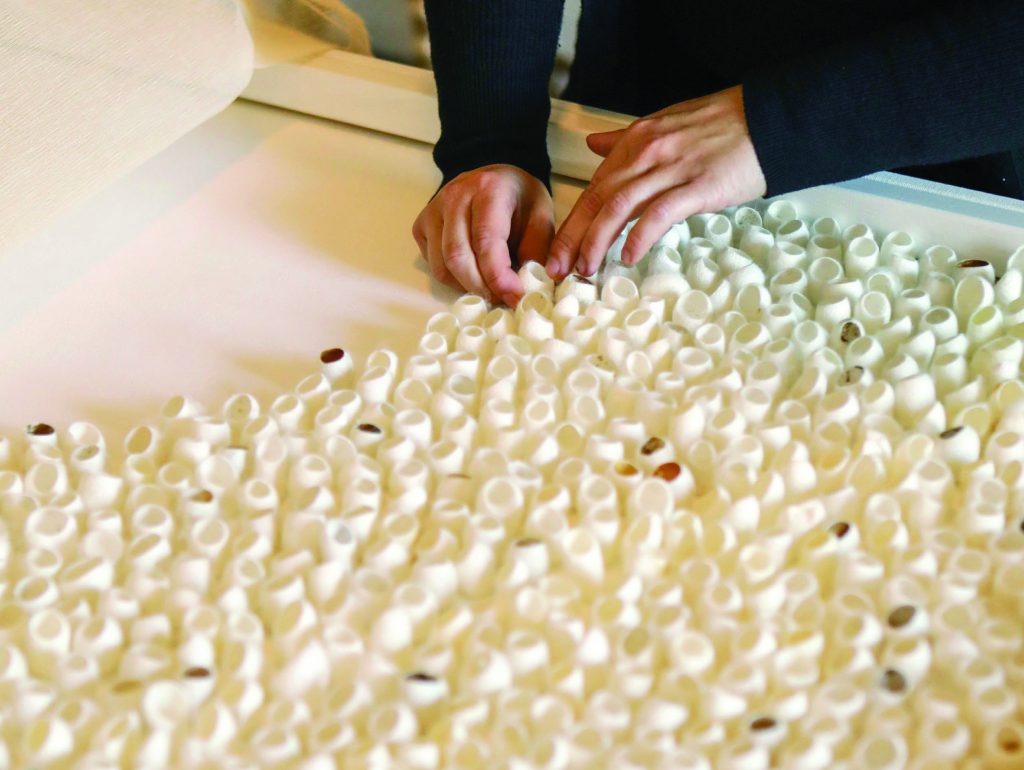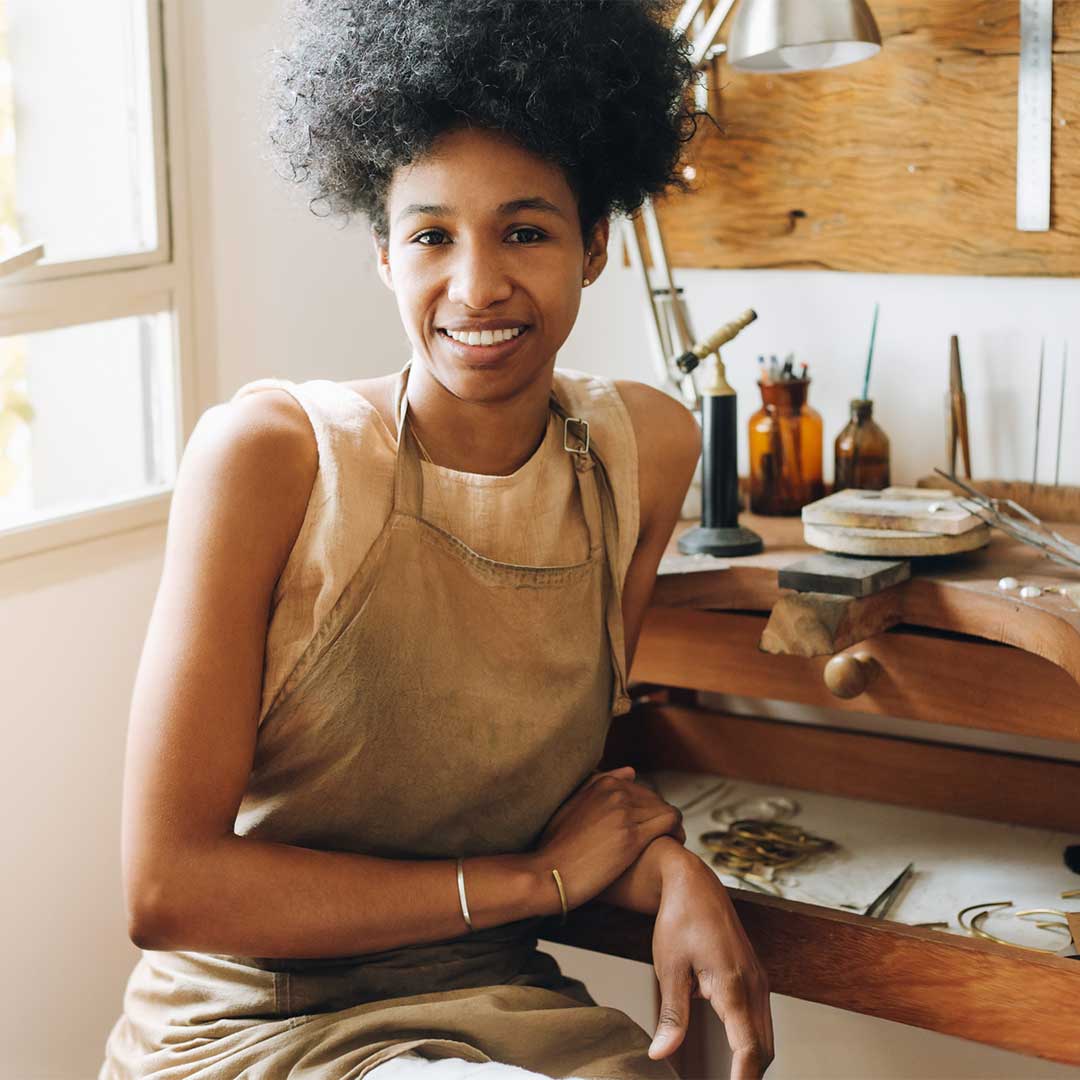“I am just the messenger, my hands have not marked this history,” is repeated over and over again in the historical documents I encounter during my investigations while conceptualizing my art. I have an MFA in poetry, and an MFA in studio art, which is to say I love research. Dedicating hours to reading and writing before I sit down at my looms enables me to slow down my process and decide which story I want to coax out of the depths. In my work, I try to pause and capture the moment that occurs where society turns away from what is happening, in an attempt to hold the viewer’s eyes open. By using history as a lens to examine the female body, I can explore the charged awareness of my own body and identity as a survivor of abuse and violence.

As a personal survivor of physical and sexual violence, I’ve found healing and self-empowerment through using my work to talk about my experience and the deeper history that ties myself and many other women together. I’m fascinated how historically women have worked within the constraints of the domestic space to express themselves, and how their mark “making” was an attempt to make the true self known; to force the female body to be seen outside of its bound, traditional context.
Through fiber art, I can convey the collective voice of women who have been pushed down but rose back up again in thousands of tiny stitches, textures and tones.
Some historical themes I’ve examined in my work include: how corsets altered women’s bodies, the Trail of Tears, Victorian mourning practices, the Triangle Shirtwaist Factory Fire and witches. Anonymous women might have been nameless, but the echo of their voices can still be felt into the present.
A particular period that has consumed me is the history of women persecuted as witches. In the era of witch hunting, any imperfection on a woman could be used as evidence as a devil’s mark and condemn her to the fire. Men systematically persecuted women who held knowledge or power, often killing midwives and healers, destroying entire matriarchal communities. Some of my artwork compares this history to man’s obsessive control and resulting destruction in nature, through the imagery of hundreds of silkworm cocoons, thousands of knots or precariously draped threads.
The labor behind the weaving and fiber construction is so important to my work. It is a medium of art where you can’t help but be floored by the hours, the precision and the repetition that is necessary to execute an idea; all of these things are a powerful metaphor for women’s work. There’s strength in this quiet, fevered language.
There’s a moment in art-making when you can feel the fear mounting inside you. It’s akin to that sensation you get when your toes hang out just over the edge of a diving board, or a rooftop; that surge of adrenaline at the prospect of a fall. You have to make a choice: face the fear and channel its power or step back and turn away from that feeling. When I started to embrace my fear and intentionally took risks in my work by telling my story, that is when my art practice opened up, and I began to truly connect with others.

It is a daily ritual for me to look out the window and remember that there is strength in vulnerability and an open heart. Through my art, I hope to pass this message on to other women.
My studio is in an old warehouse in a former industrial district in Kingston, New York. When I first looked at my studio, I was struck with possibility and all that this blank slate of a room could mean for my work and me. It was the dead of January, but out the window was this remarkable mural on the women’s shelter across the street. Illuminated in bright colors were the words, “Dear survivor, to love yourself is to become free.” As a survivor of physical and sexual violence, and as an artist who uses my work as a lens to interrogate this identity, I read these words, and I knew I’d come home; I’d found my studio.
I still feel a surge of power, light and healing every time I look out this window and see the beautiful work of Jess Snow, Layqa Nuna Yawar and Tani Ikeda. This mural reminds me daily that my voice, and my self, matter. When I read Tani Ikeda describing what this project meant for her, it felt like I, too, had been seen.

In this special space of mine, I promote mindfulness by hosting weaving workshops that focus on learning to weave intuitively. Taught more as art classes versus craft training, the overall course is framed to trust the artistic voice of each individual who steps into my studio as each has something unique to say through their work. Students are asked to bring a photograph of a landscape that holds emotional resonance for them. I share my creative process and then lead them in an exercise where they sketch and “write into” their image and connect with what it sparks for them. Next, they take their concept and pull from my yarn and fiber collection to find what textures speak to the feeling they want to convey in their artwork. It’s only after this poetic interrogation where my students have grown that seed of trust in each of their artistic voices that I move on to teaching them the basics of weaving on a frame loom.
Holding a safe space and developing a community for women and other artists where they can push themselves creatively has had a profound impact on my work. I recently created the Weaving Coven where anyone who has taken a workshop with me or who has a background in fiber can join our gatherings, which combine all the best parts of in-progress critiques, therapy and quilting bees.
“I am just the messenger, my hands have not marked this history,” is repeated over and over again in the historical documents I encounter during my investigations while conceptualizing my art. I have an MFA in poetry, and an MFA in studio art, which is to say I love research. Dedicating hours to reading and writing before I sit down at my looms enables me to slow down my process and decide which story I want to coax out of the depths. In my work, I try to pause and capture the moment that occurs where society turns away from what is happening, in an attempt to hold the viewer’s eyes open. By using history as a lens to examine the female body, I can explore the charged awareness of my own body and identity as a survivor of abuse and violence.

As a personal survivor of physical and sexual violence, I’ve found healing and self-empowerment through using my work to talk about my experience and the deeper history that ties myself and many other women together. I’m fascinated how historically women have worked within the constraints of the domestic space to express themselves, and how their mark “making” was an attempt to make the true self known; to force the female body to be seen outside of its bound, traditional context.
Through fiber art, I can convey the collective voice of women who have been pushed down but rose back up again in thousands of tiny stitches, textures and tones.
Some historical themes I’ve examined in my work include: how corsets altered women’s bodies, the Trail of Tears, Victorian mourning practices, the Triangle Shirtwaist Factory Fire and witches. Anonymous women might have been nameless, but the echo of their voices can still be felt into the present.
A particular period that has consumed me is the history of women persecuted as witches. In the era of witch hunting, any imperfection on a woman could be used as evidence as a devil’s mark and condemn her to the fire. Men systematically persecuted women who held knowledge or power, often killing midwives and healers, destroying entire matriarchal communities. Some of my artwork compares this history to man’s obsessive control and resulting destruction in nature, through the imagery of hundreds of silkworm cocoons, thousands of knots or precariously draped threads.
The labor behind the weaving and fiber construction is so important to my work. It is a medium of art where you can’t help but be floored by the hours, the precision and the repetition that is necessary to execute an idea; all of these things are a powerful metaphor for women’s work. There’s strength in this quiet, fevered language.
There’s a moment in art-making when you can feel the fear mounting inside you. It’s akin to that sensation you get when your toes hang out just over the edge of a diving board, or a rooftop; that surge of adrenaline at the prospect of a fall. You have to make a choice: face the fear and channel its power or step back and turn away from that feeling. When I started to embrace my fear and intentionally took risks in my work by telling my story, that is when my art practice opened up, and I began to truly connect with others.

It is a daily ritual for me to look out the window and remember that there is strength in vulnerability and an open heart. Through my art, I hope to pass this message on to other women.
My studio is in an old warehouse in a former industrial district in Kingston, New York. When I first looked at my studio, I was struck with possibility and all that this blank slate of a room could mean for my work and me. It was the dead of January, but out the window was this remarkable mural on the women’s shelter across the street. Illuminated in bright colors were the words, “Dear survivor, to love yourself is to become free.” As a survivor of physical and sexual violence, and as an artist who uses my work as a lens to interrogate this identity, I read these words, and I knew I’d come home; I’d found my studio.
I still feel a surge of power, light and healing every time I look out this window and see the beautiful work of Jess Snow, Layqa Nuna Yawar and Tani Ikeda. This mural reminds me daily that my voice, and my self, matter. When I read Tani Ikeda describing what this project meant for her, it felt like I, too, had been seen.

In this special space of mine, I promote mindfulness by hosting weaving workshops that focus on learning to weave intuitively. Taught more as art classes versus craft training, the overall course is framed to trust the artistic voice of each individual who steps into my studio as each has something unique to say through their work. Students are asked to bring a photograph of a landscape that holds emotional resonance for them. I share my creative process and then lead them in an exercise where they sketch and “write into” their image and connect with what it sparks for them. Next, they take their concept and pull from my yarn and fiber collection to find what textures speak to the feeling they want to convey in their artwork. It’s only after this poetic interrogation where my students have grown that seed of trust in each of their artistic voices that I move on to teaching them the basics of weaving on a frame loom.
Holding a safe space and developing a community for women and other artists where they can push themselves creatively has had a profound impact on my work. I recently created the Weaving Coven where anyone who has taken a workshop with me or who has a background in fiber can join our gatherings, which combine all the best parts of in-progress critiques, therapy and quilting bees.















